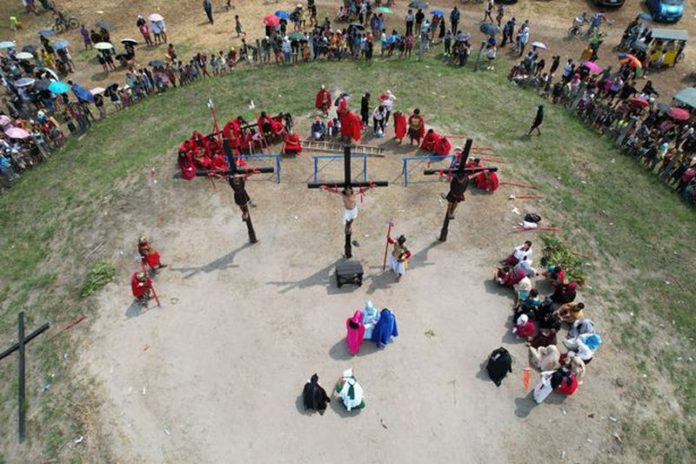Eight people were nailed to crosses to reenact Jesus Christ’s suffering in a gory Good Friday tradition that draws thousands of devotees and tourists to the Philippines despite being rejected by the Catholic church.
The real-life crucifixions in the farming village of San Pedro Cutud in Pampanga province north of Manila resumed after a three-year pause due to the coronavirus pandemic.
About a dozen villagers registered but only eight men participated, including 62-year-old sign painter Ruben Enaje, who was nailed to a wooden cross for the 34th time in San Pedro Cutud.
In a news conference shortly after his brief crucifixion, Enaje said he prayed for the eradication of the Covid-19 virus and the end of Russia’s invasion of Ukraine, which has contributed to gas and food prices soaring worldwide.
“It’s just these two countries involved in that war, Russia and Ukraine, but all of us are being affected,” said Enaje, who appeared to be well and showed his two bandaged hands to journalists.
The father of four said he wanted to end his extraordinary penitence because of his age but would decide with finality before Lent next year.
While the pain from the nailing was not as intense as anticipated, he said he always felt edgy before each crucifixion.
“To be honest, I always feel nervous because I could end up dead on the cross,” he said before Friday’s nailing.
“When I’m laid down on the cross, my body begins to feel cold,” he said. “When my hands are tied, I just close my eyes and tell myself, ‘I can do this. I can do this.”‘
Surviving nearly unscathed when he fell from a three-story building in 1985 prompted Enaje to undergo the ordeal as thanksgiving for what he considered a miracle.
He extended the ritual after loved ones recovered from serious illnesses, one after another, turning him into a village celebrity as the “Christ” in the Lenten reenactment of the Way of the Cross.
Ahead of their crucifixion on a dusty hill, Enaje and the other devotees, wearing thorny crowns of twigs, carried heavy wooden crosses on their backs for more than a kilometre (more than half a mile) in the scorching heat.
Village actors dressed as Roman centurions later hammered 4ins (10cm) stainless steel nails through his palms and feet, then set him aloft on a cross under the sun for about 10 minutes
Other penitents walked barefoot through village streets and beat their bare backs with sharp bamboo sticks and pieces of wood.
Some participants in the past opened cuts in the penitents’ backs using broken glass to ensure the ritual was sufficiently bloody.
The gruesome spectacle reflects the Philippines’ unique brand of Catholicism, which merges church traditions with folk superstitions.
Many of the mostly impoverished penitents undergo the ritual to atone for sins, pray for the sick or for a better life, and give thanks for miracles.
Church leaders in the Philippines have frowned on the crucifixions and self-flagellations, saying Filipinos can show their deep faith and religious devotion without hurting themselves and by doing charity work instead, such as donating blood.


